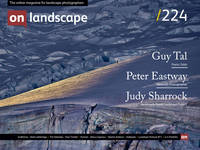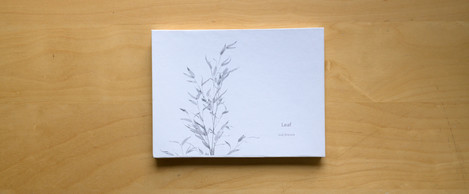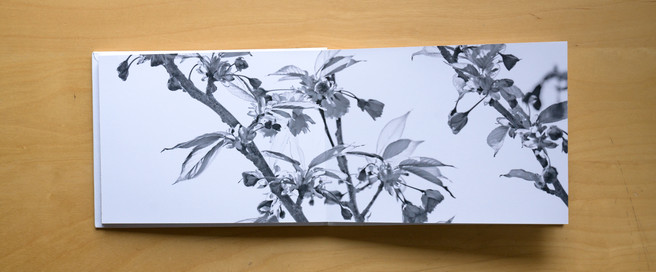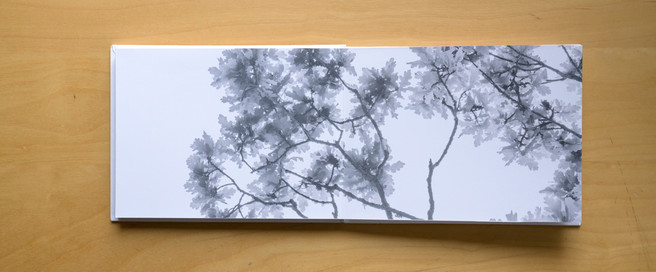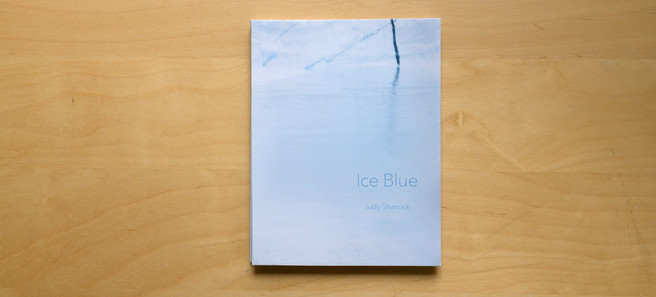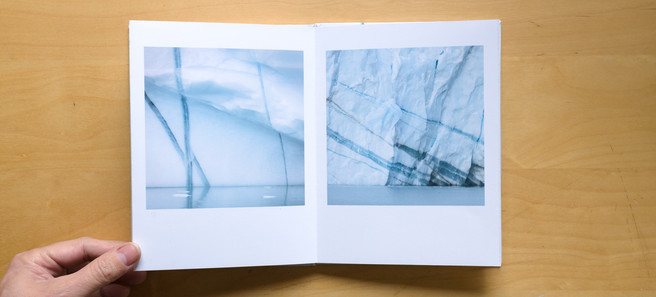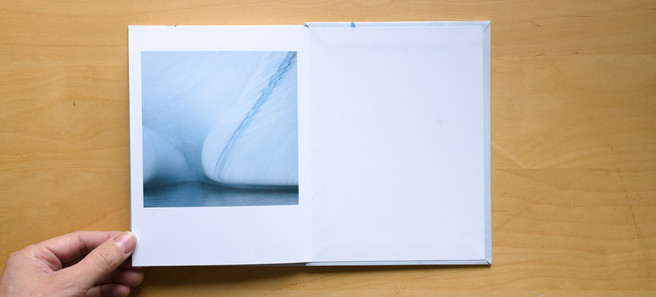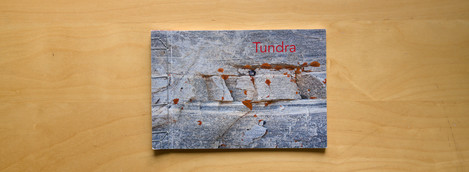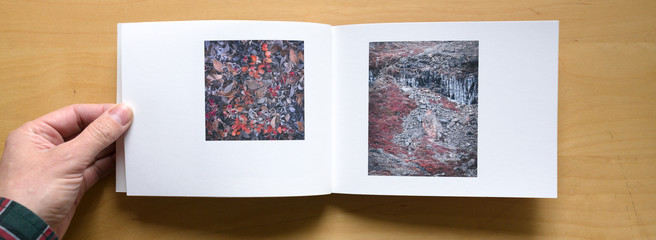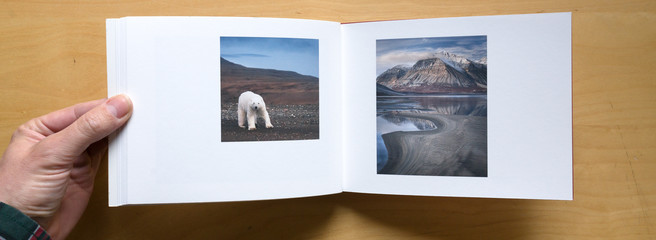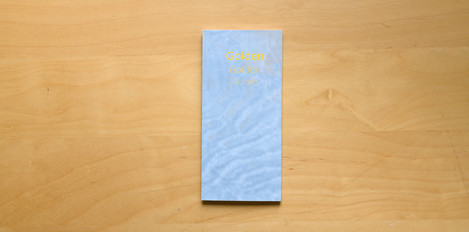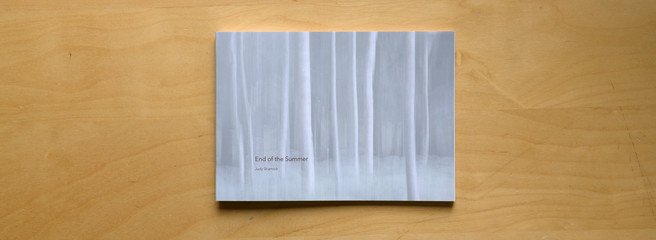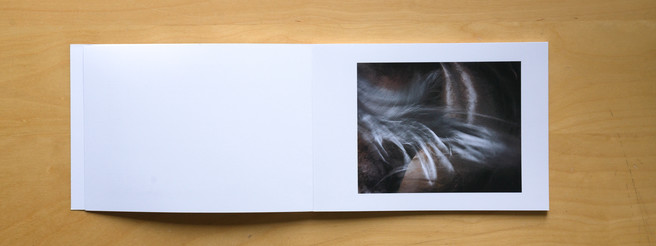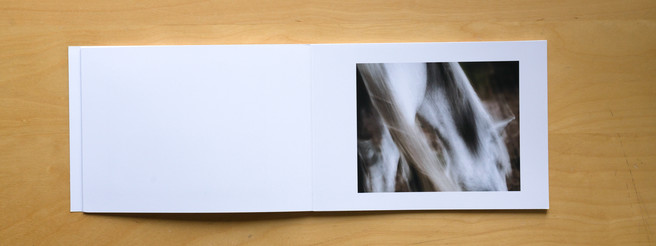Handmade Books Lockdown Project

Judy Sharrock
Judy is a late and recent convert to the joys of photography. She lives in the New Forest but also has a house in Mellon Charles on the North West coast of Scotland, so both areas provide plenty of scope to develop her landscape skills in two contrasting but beautiful parts of Great Britain. (Author image taken by Julia Moffat.)

Tim Parkin
Amateur Photographer who plays with big cameras and film when in between digital photographs.
TP: We have been trying to get together for some time and after a few things getting in the way, we are now, finally, going to have our chat about your lovely handmade books. Hello and welcome Judy!
JS: Hello Tim and thank you.
TP: I have in front of me a range of 5 of your handmade books and I wanted to chat with you about how you got into making books. Also, the techniques involved and what has inspired you for the content of these books.
Firstly, over what time period were these books produced?
JS: These books have all been produced post “lockdown”. It was something I got inspired to do during lockdown. So they have all been produced since June I believe.
TP: Oh wow, so quite a short period of time. Have you been a landscape photographer for long?
JS: No, I took up landscape photography in 2013 after I had been retired from work for a few years. Though two or three different things came together at the same time to make it happen. Firstly I had been taking a lot of photographs of horses and happened to see an advert in our local post office advertising evening classes in A level photography. I thought it would be a fun thing to do, and it was. At the same time, we were building a house in northwest Scotland, which happened to be next door to Adrian Hollister’s Perfume and Open Studio where he was running a series of workshops. Adrian and I became friends and he gave me a huge amount of help to get started. We did a workshop with Adrian, Eddy Ephraums, Joe Cornish and Paul Sanders. That was life changing for me, that is what kickstarted me into landscape photography.
TP: Quite a useful start there! Also, the beautiful highland landscape to work with as well.
JS: Definitely a good starting point. At home, I live in the new forest so that is not too shabby. However, I find the new forest quite hard to photograph in. Very little of what I have done is down here. Which is something I plan to change, however, I have not done, yet.
TP: So in terms of bookmaking, I know that Mr Hollister has run a few workshops where handmade books have been involved. Have you been on any of those?
JS: I have done one a couple of weeks ago. However, I have not done any before then. I did get involved with Eddy making a book, a very different sort of book. I got very intrigued in the bookmaking process at that time and I planned to, but never got round to doing it. Come lockdown, I saw that Alex Hare and Lizzy Shepherd were running some online bookmaking workshops. At the same time, I had started to try and make the first of the books that you have in front of you. So, I signed up for that which was really helpful and got me going. From there I bought all the kit required and put it into practice.
TP: Tell me which book was your first book out of the five I have. Also, tell me what intrigued you about the bookmaking process and what you learnt on the course?
JS My first one is called “Leaf”. What intrigued me about the process, was the idea of putting images together. Someone on the first course I took said, “One image on its own no longer satisfies”. It’s a new dimension of putting them all together. What I learnt with Alex and Lizzy was the techniques of making “Hard” covers for books. Then the different ways and styles of putting them together; in my time with Eddy I had never put hardcovers on them before.
TP: This is one thing I found quite intriguing and visually compelling about the books is the beautifully wrapped images and the hardcovers. Let’s talk about your first book, “Leaf”. Tell me about the photographs within and then the technique you used to make the book.
JS: This was very much a lockdown book. We had all been plunged into this lockdown and everyone reacted to it in different ways. I didn’t really feel like doing any photography - however, one day I had to get my camera out and just get on with it. I am very lucky that I live in a place with some nice land and a lovely garden. I took a few images and then went to play with some of them. It was in summer, so it was hot with blue skies. I thought that high key images might be fun. I did one image that I really liked and a few others. I went away and thought maybe it was something I could turn into a book. I created this high-key image of cherry blossom, so went round the garden and took images of different trees in the garden. Then I produced the book from that. So this book is composed just of different trees in my garden.
TP: Since you started with a “double page spread”. It is effectively a 3:1, or a 6:17 aspect ratio, did you have the idea of the book and took the photographs to match or did it happen the other way around?
JS: No, it happened the other way around. I had seen a book of Lizzy Shephard’s that she had done with Tulips, which had no frames to them and it ran to the edges of the book. I really liked that idea and I thought it worked quite well with these images. I like the idea of the “slices of the trees”, the fact you can recognise each type of tree from a fairly small section of it.
TP: Down to the bookmaking itself, what is involved in producing these? Is it quite involved or is it something that anyone could do?
JS: Anyone can do it. Once you understand how the process works and the techniques involved, it is down to how you want to construct it. My first attempt at constructing “Leaf” I did before the workshop with Alex and Lizzy. With guidance from them, I refined the techniques. Better paper, constructing the hardcover, sizing and framing. Then you work out how you stick all the pages together and the different types of book you can make.
I like the idea of using an image on the cover as it pulls you into the book. You can buy some beautiful papers to cover the card with if you like, however, I like the cover to become part of the book as well as the pages within the book itself.
TP: With the sequencing, what was the thought behind the order of the pages and the prints within?
JS: There is probably less thought behind this one, however, there is much more thought behind the other such as “Ice Blue”. The sequencing in this book to me is what makes it. There was a lot of cropping involved to make this one work. They were not all just as they were. It is the sequencing and the way the images flow from one to another works for me. How the lines all carry on throughout the book.
TP: This (Ice Blue) is very much about line and form. These striking clear sections through icebergs carrying on from page to page. I am intrigued about this book, most people who think about books of any sort think “how am I going to get so many pictures together to fill a whole book” and yet this is almost a mini portfolio of 5 or 6 images brought together. Most people would have enough of these sort of images in their collection already to try this with.
JS: This is a perfect lockdown project. You can go back through all your images and find sets like this that lend them to bookmaking. As you say it doesn’t have to be a massive book. Somebody referred to little books like this as a “mini and individual works of art” rather than books. They are a different way of displaying your images. This book, “Ice Blue” is a concertina style book. You can pull it out and put it on a table and it is a very nice way of displaying them
TP: They are individual artefacts. They are not mass produced, they are handcrafted and brought together. It would be difficult to mass produce them. I know people who have done a series of them, a series of 4 or 5 rather than a series of 1000s.
Let’s look at another book. I loved some of the images in the Tundra book. It is a different way of producing them. This one is stitched, so tell us how the book is made.
JS: This is called JSB – Japanese Stab Binding. In essence, when you size up each page you could just print them out of lightroom. You could create a blank book this way and then stick them in the book rather than constructing the book by printing all the pages and then binding them together. There are many things you can do using this technique. So in creating this book you have to make sure that all your sizing works. You have to make sure that you have the strip down the edge where you will bind the book. You have to crease it as well to make sure that the pages turn. The actual sewing is very simple and straight forward once you know how to do it. This makes a book that most people are familiar with. It has pages you can turn where other styles don’t. I experimented with the cover with this one. It is two types of paper stuck together but not convinced that this style works for me, but I was willing to give it a try.
TP: Please tell me more about the project surrounding the images in this book. There are some beautiful images in here.
JS: I was very lucky last year to go on a trip to East Greenland organised by Anthony Spencer and Joe Cornish. They took 12 of us on a small ice breaker up to the northeast area of Greenland. This is a very unvisited part of the world. All the ships follow designated shipping routes and the ships crew showed us that we were going back to the old days away from these routes. It was a proper adventure as well, as the crew of the ship had not been to these places before as it is only ice free for a few weeks of the year. We were very lucky to have amazing weather in September that year. At that time, it can be wiped out by the snow and ice. What fascinated me the most, we were there in autumn and you could see this in the ground. The colours were absolutely amazing, in a totally different way compared to back here, I thought it would be a fun way to show Greenland not in the ice and snow. Show off some amazing colours.
TP: We would like to feature some of these images in the article as I think they are very strong images. Was it easy to pick out the images to use for this book from the photographs from this trip?
JS: It was easier than it might have been for other things. It was fun, you could put images in that had polar bears in them! However, the book was about the Tundra. It is about what Greenland looks like in autumn, not only about the astonishing big landscapes, also what is going on at your feet as well. The other folks joked that I spent more of my time with my camera facing the ground than the landscape.
TP: Although I can imagine the most interesting part is what is going on at ground level.
JS: The Tundra is like mini forests that are only a couple of inches high and they grow very little. They are tiny, but the colours and the intricacy of them were amazing.
TP: This is another one of your books that I found interesting, it is very tall and thin. It is a book in a sleeve, it looks like it is from the west coast of Scotland with amazing geology, Eigg or Arran. Lots of folded iron rich ridges and cool blue sands. Whereabouts is the project from and can you describe to me what was involved in making this book?
JS: It was taken on the Isle of Eigg. I made this book on a recent workshop with Eddy and Adrian up at the perfume studio. I like the idea that the images are very similar, and you can put them together with no borders, so they all run into each other. At times it can be difficult to tell if it is one big image or several smaller ones.
TP: I like this one as it is another concertina book so you can hold it out almost into a long strip and it creates a textural, rhythmic image.
JS: It is a good example of what fun you can have with bookmaking. You can almost make it up as you go along. It doesn’t have to conform to a “Standard book”, the sky is the limit in respect to what you can make out of a book.
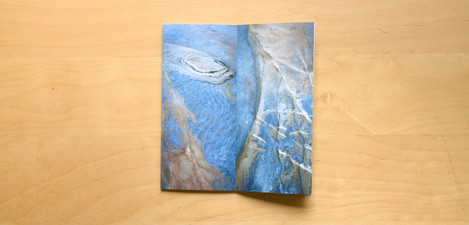
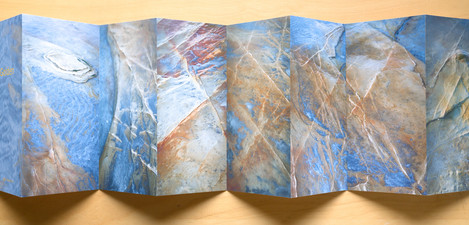
TP: The fascinating thing about this, is being able to make crops or aspect ratios that you would rarely use or see in a portfolio.
JS: The piece of rock that they are portraying is only 4 or 5 m2 and the tide was coming over it, washing sand on and off them creating different images in the same piece of rock.
TP: Now we will look at an aptly named book called “End of the Summer”. This is a simpler book without the hardback covers. Please tell me about the book.
JS: This is another one that I did at the workshop, it is called a “Layout book”. It’s a type of concertina book. However the pages are stuck together differently so you can open each page out flat, Eddy used the same technique to make Paul Sanders’ book Solace. It’s a nice structure for a more traditional book, very simply made.
TP: I like this technique and the concertina technique as you can open the book fully at an image and see it in its entirety without bending the book. With the JSB you have to almost bend the images to open the book up. Tell me more about the book and project, End of summer.
JS: This was shot in the new forest, I shot it all in one afternoon. I have a love hate relationship with ICM. I did some, one summer’s afternoon, again a hot summer’s day. I have been interested in horses, one of my passions. So I went to see what the ponies were up to, it just came from an afternoon out seeing them and being in the forest. The feel of it for me, captures how it felt that afternoon. Very hot, tired and dusty, very simple.
TP: I went on a workshop with Lizzy Shepherd, but it was a John Blakemore bookmaking workshop a while back. At the time I didn’t have any images that I thought would work together in a book. So I went out and took pictures in an afternoon and it was brilliant, maybe none of them would work on their own, however in a book together they did. The ability to use editing and context in a project to make something coherent is a different way of looking at photography rather than the individual picture.
JS: Definitely totally agree. I have it in the back of my mind now when I go out. I will occasionally look at a picture and think, will this make a sequence, its like having a totally new dimension to photography. Thinking, “can these pictures go together or not?”
TP: Has bookmaking made you think differently about your photography outside?
JS: I think it makes me look at things differently when I start processing them. I might see something that had potential, then go and take more images of it. I am currently working on a book on Lilys. I took maybe more images of that pond as I did think that there could be a book there. It probably translates to more images rather than different images.
TP: Thank you. We will look forward to seeing the Lily book in due course I’m sure.

